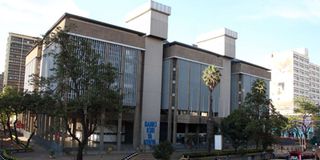Strengthen financial reporting centre

The Central Bank of Kenya headquarters in Nairobi in this picture taken on September 15, 2020.
What you need to know:
- Put simply, FRC’s prime responsibility is to record and monitor suspicious transaction and to ensure that all financial institutions oblige to legal requirements of suspicious transactions reporting.
We must not forget the role the FRC and the Central Bank of Kenya played in blowing the whistle on the suspicious payments in the initial stages of the NYS scandal.
I have read through an intelligence report by the Financial Reporting Centre (FRC) detailing loopholes merchants of graft at the county government of Nairobi have been exploiting to siphon off billions of shillings out of a special fund known as the Alcoholics Drinks Control and Licensing Fund.
In that report, we see how city fathers had converted this multimillion-shilling special fund into a source for channelling out corrupt payments to well-connected contractors. The report reveals that between April 2007 and October 2020, a whopping Sh1.24 billion was paid out from this fund to a network of contractors under very suspicious circumstances. The findings are very revealing because as we all know, reports by the FRC are usually very credible. The agency does not just give you conjecture and unsubstantiated claims.
Instead, FRC investigations follow movement of money from one bank account to another, giving you details of the names of individuals and entities who received the cash. I found myself debating the justification for existence of such an opaque fund and whether City Hall had more of such slush funds.
Special fund
What is it that made this fund such a convenient target for City Hall’s corrupt elites? You have to go back to the history of the fund and the reason why it was created in the first place. You will find that it was created as a special fund to be operated outside the mainstream public finance management framework. It was to be an earmarked and ring-fenced fund for the financing of the operations an autonomous alcoholics licensing and control board and its sub-county committees.
In 2014, Parliament passed a law stipulating that ‘the monies payable to the fund shall not form part of the Revenue Fund for the county government’. It is this opaque legal arrangement that has allowed successive city fathers to treat the fund as a slush fund.
I will not dwell on the details of the transactions in the report by the FRC because this story has already been reported widely in the daily press. My interest is in this entity known as FRC. This is a good conjuncture to assess its powers and role- and debate what needs to be done to strengthen the powers of this little-known but extremely powerful government agency so that it can play a bigger role within in the anti -corruption fight.
A bit of history. We created the FRC hurriedly in 2012 because of pressure from the Financial Action Task Force (FATF). This is the international body that co-ordinates compliance by banks and financial institutions with regulations governing anti-money laundering laws.
As a matter of fact, we only passed the anti-money laundering law and the law creating the FRC after we were threatened with a blacklist by FAFT and when we realised that we risked losing correspondent banking relationships with the rest of the World if we did not pass an anti-money laundering law within the time-frame we were given.
Put simply, FRC’s prime responsibility is to record and monitor suspicious transaction and to ensure that all financial institutions oblige to legal requirements of suspicious transactions reporting. Enough of history. I think that if we strengthened FRC’s capacity to report suspicious transactions, enhanced its powers to trace, seize, and confiscate suspicious cash transactions, some of the grand corruption transactions – such as the looting of the Alcoholics Drinks Licensing Fund – that we see today will not happen as easily as they do.
DusitD2 terrorist attack
It is the FRC that can force our banks and financial institutions to take the job of reporting suspicious transactions more seriously. Currently, the law requires commercial banks to report all transactions above Sh1 million to the FRC daily.
But the problem is that even though the FRC currently, receives and processes information on suspicious transactions it does not have a database robust enough to process all the information it receives and to flag the suspicious transactions on a real time basis.
With the limited data capability, FRC cannot provide information that that can make it possible for authorities to stop the suspicious transactions before they happen. We must not forget the role the FRC and the Central Bank of Kenya played in blowing the whistle on the suspicious payments in the initial stages of the NYS scandal.
Months later, the governor of the Central Bank of Kenya, Dr Patrick Njoroge came out – for the first time in the country’s history – to slap fines on banks for lapses and poor reporting of illegal payments that facilitated the laundering by corrupt elites of billions through the banking system.
Nearly all our top banks were found to have shown material weaknesses and lapses in reporting suspicious transactions. If we are serious about stopping corruption, let’s start strengthening the FRC – by turning it into a powerful autonomous body. And, we need to urgently bring mobile money into the orbit of institutions that report suspicious transactions. Didn’t we learn a lesson from the DusitD2 terrorist attack?





